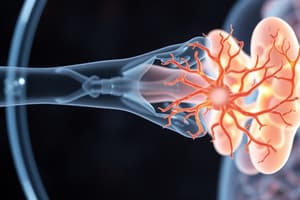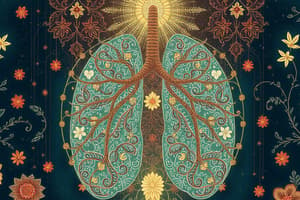Podcast
Questions and Answers
What forces act to move gases across the membrane?
What forces act to move gases across the membrane?
The pressure and concentration gradients of the gases involved.
Some features of the lungs give them a large surface area. Suggest one.
Some features of the lungs give them a large surface area. Suggest one.
The alveoli are microscopic air sacs that create a large surface area for gas exchange. And the bronchioles, the small airways, are extensively branched, further increasing surface area.
A person with what respiratory ailment may experience shortness of breath and low energy levels during exercise?
A person with what respiratory ailment may experience shortness of breath and low energy levels during exercise?
The most likely ailment is asthma. Asthma is a chronic respiratory condition where the airways are inflamed and narrowed, making it difficult to breathe, especially during physical exertion.
Explain how the structure of the small intestine helps in the absorption of the products of digestion.
Explain how the structure of the small intestine helps in the absorption of the products of digestion.
Flashcards
Diffusion
Diffusion
The process where gases move across a membrane from high to low concentration.
Alveoli
Alveoli
Small air sacs in the lungs where gas exchange occurs.
Blood capillaries
Blood capillaries
Tiny blood vessels surrounding alveoli that transport gases.
Short diffusion pathway
Short diffusion pathway
Signup and view all the flashcards
Large surface area
Large surface area
Signup and view all the flashcards
Emphysema
Emphysema
Signup and view all the flashcards
Alveolar wall breakdown
Alveolar wall breakdown
Signup and view all the flashcards
Gas exchange
Gas exchange
Signup and view all the flashcards
Respiratory system
Respiratory system
Signup and view all the flashcards
Structure of the small intestine
Structure of the small intestine
Signup and view all the flashcards
Villi
Villi
Signup and view all the flashcards
Microvilli
Microvilli
Signup and view all the flashcards
Absorption
Absorption
Signup and view all the flashcards
Oxygen transport
Oxygen transport
Signup and view all the flashcards
Nutrient uptake
Nutrient uptake
Signup and view all the flashcards
Capillary function
Capillary function
Signup and view all the flashcards
Alveolar gas exchange
Alveolar gas exchange
Signup and view all the flashcards
Breathe
Breathe
Signup and view all the flashcards
Healthy lungs
Healthy lungs
Signup and view all the flashcards
Exercise effects on lungs
Exercise effects on lungs
Signup and view all the flashcards
Study Notes
Changing Substances
- Gases move across membranes by diffusion
- Lungs have a large surface area and short diffusion pathway, facilitating gas exchange.
- Emphysema weakens and breaks down alveoli walls, leading to lower energy levels during exercise.
- This is because the reduced surface area and increased diffusion distance in the lungs compromise gas exchange efficiency, leading to reduced oxygen intake and compromised energy levels.
- The small intestine's structure is adapted for absorption of digested food products. Specific adaptations enhance its absorptive capacity.
Studying That Suits You
Use AI to generate personalized quizzes and flashcards to suit your learning preferences.




